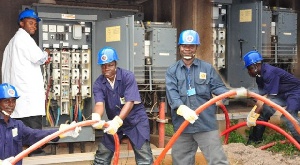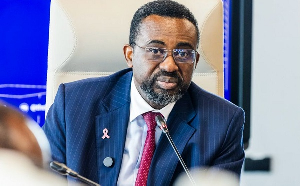Decades of underinvestment, significant system losses and mismanagement by the Electricity Company of Ghana (ECG) was evident last Thursday, as large parts of the country were plunged into darkness following collapse of the electricity distributor’s system.
An ECG source on Thursday is quoted as saying: “We have just been informed by our engineers that there is a system collapse - so all our lines are down, which we are actually working on to resolve and restore power.
“All our lines are down; it’s nationwide. As at now we are unable to tell the particular time we will be able to finish work and restore power, but we are working on it.”
The problem, which has since been resolved, highlights the deep-seated challenge of under investment.
The ECG estimates that it requires a sustained investment of about US$200million every year to address its investment gap, in order to meet the growing annual power demand of about 12 percent.
However, consumers’ indebtedness to the ECG and years of unrealistic tariffs have largely resulted in under investment in new energy distribution facilities, maintenance of existing lines and replacement of old distribution lines. This has also aggravated the challenge of system losses -- currently at around 25%.
Government’s indebtedness to the ECG, inferred through the consumption of power by various ministries, departments and agencies (MDAs) and other state institutions as contained in a statement issued by ECG, Volta River Authority, and Ghana Grid Company Limited (GRIDCo), is about GHC1.2billion -- which constitutes some 62 percent of ECG’s total debt.
The immediate-past Power Minister, Kwabena Donkor, was however firm in his conviction that government does not owe the ECG.
He told B&FT in December that: “Technically, government does not owe because government is servicing ECG, VRA and GRIDCo debts; and if we do the offset, which we must do in accounting, we will realise that the owing is the other way round. That is why I don’t make much noise about government’s debt, because I know the reality”.
The Public Utilities Regulatory Commission (PURC) in December 2015 announced a 59.2 percent increase in electricity tariffs, ostensibly to help the utilities meet their operational costs.
Tariffs have not been cost-reflective over for years. For instance, the largest power producer’s (VRA) cost of production is about 26 pesewas per kilowatt hour.
Prior to the December increment in tariffs, it was only allowed to charge about 14 pesewas per kilowatt hour for the power it sells to ECG and Northern Electricity Department of the VRA. The ECG also distributed the power at a high cost relative to the revenue it gets.
Given the legacy of mismanaging the ECG, government is to give it out in a concessionary arrangement to a private entity for between 20-30 years to “manage, operate and invest”.
MiDA insists, though, that the injection of private capital will be one of the key conditions precedent before the ECG is handed over to a concessionaire. According to Millennium Development Authority (MiDA), a concessionaire should be chosen by the end of 2016.
“The concessionaire, apart from managing, will have to put in investments; and once it puts in investments it has to ensure that the company (ECG) is profitable. It is only when the company is profitable that the concessionaire will be able to get its own returns back, and therefore this arrangement is a much better one than a management contract,” CEO of MiDA, Owura Kwaku Sarfo, told the B&FT in an earlier interview.
The International Finance Corporation (IFC) of the World Bank Group, which has been chosen by MiDA as transaction advisor, has completed its initial due diligence activities in respect of the ECG and the report is under review.
Energy sector levies face resistance
The passage of an Energy Sector Levy (ESL) by Parliament in December 2015 has led to an increase of about 30 percent increase in prices.
The Energy Levy is the latest tax to be imposed on petroleum products barely 14 months after a Special Petroleum Tax of 17.5 percent was introduced -- principally to raise more funds to settle the energy sector debts and prevent future load-shedding.
“It is important that the Ghanaian public appreciates why government has had to take those difficult but necessary decisions to stabilise the economy and fix the energy crisis, and to prevent it from relapsing into a deeper crisis.
“Government currently has outstanding debts which are all within the energy sector, and were part of the report the Minister of Finance submitted to Parliament. And therefore the energy sector levy introduces among others a price stabilisation adjustment that will allow government to deal with the 4.5 billion outstanding debt,” Employment and Labour Relations Minister Haruna Iddrisu told an Accra-based radio station.
The energy policy think-tank African Centre for Energy Policy (ACEP) analysis shows the new levies will gross at least GHC3.2billion annually, based on volumes of petrol, diesel and LPG consumed in 2015.
Government is estimated to earn some GHC5billion from taxes on petroleum products annually, inclusive of all existing levies on petroleum products.
The levies, described by organised labour as “insensitive”, have been met with stiff resistance by the public, which points to the current world prices of crude.
The Trade Union Congress, on Wednesday, embarked on a nation-wide demonstration against the levies -- calling on government to go back to Parliament and reverse the law. They also called for a reduction in tariff hikes announced by the PURC.
Government’s attempt to calm nerves has come in the form resuming negotiations with organised labour about a possible review of the tariffs announced by the PURC. Government is however uncompromising on a review of the Energy Sector Levy.
Business News of Friday, 22 January 2016
Source: B&FT













